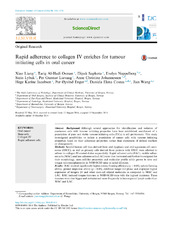| dc.contributor.author | Liang, Xiao | en_US |
| dc.contributor.author | Osman, Tarig Al-Hadi | en_US |
| dc.contributor.author | Sapkota, Dipak | en_US |
| dc.contributor.author | Neppelberg, Evelyn | en_US |
| dc.contributor.author | Lybak, Stein | en_US |
| dc.contributor.author | Liavaag, Per Gunnar | en_US |
| dc.contributor.author | Johannessen, Anne Christine | en_US |
| dc.contributor.author | Jacobsen, Hege Karine | en_US |
| dc.contributor.author | Enger, Per Øyvind | en_US |
| dc.contributor.author | Costea, Daniela Elena | en_US |
| dc.contributor.author | Wang, Jian | en_US |
| dc.date.accessioned | 2015-03-24T15:46:03Z | |
| dc.date.available | 2015-03-24T15:46:03Z | |
| dc.date.issued | 2014-12 | eng |
| dc.identifier.issn | 0959-8049 | |
| dc.identifier.uri | https://hdl.handle.net/1956/9634 | |
| dc.description.abstract | Background: Although several approaches for identification and isolation of carcinoma cells with tumour initiating properties have been established, enrichment of a population of pure and viable tumour-initiating cells (TICs) is still problematic. This study investigated possibilities to isolate a population of cancer cells with tumour initiating properties based on their adherence properties, rather than expression of defined markers or clonogenicity. Methods: Several human cell lines derived from oral dysplasia and oral squamous cell carcinoma (OSCC), as well as primary cells derived from patients with OSCC were allowed to adhere to collagen IV-coated dishes sequentially. Rapid adherent cells (RAC), middle adherent cells (MAC) and late adherent cells (LAC) were then harvested and further investigated for their morphology, stem cell-like properties and molecular profile while grown in vitro and tongue xenotransplantation in NOD-SCID mice at serial dilutions. Results: RAC showed significantly higher colony forming efficiency (p < 0.05), sphere forming ability, greater migration ability (p < 0.05), exhibited longer G2 phase and displayed higher expression of integrin b1 and other stem-cell related molecules as compared to MAC and LAC. RAC induced tongue tumours in NOD-SCID mice with the highest incidence. These tumours were also bigger and metastasised more frequently in loco-regional lymph nodes than MAC and LAC. Conclusions: These findings prove for the first time that OSCC cells with tumour initiating properties can be enriched based on their rapid adhesiveness to collagen IV. This separation procedure provides a potentially useful tool for isolating TICs in OSCC for further studies on understanding their characteristics and drug-resistant behaviour. | en_US |
| dc.language.iso | eng | eng |
| dc.publisher | Elsevier | eng |
| dc.rights | Attribution-NonCommercial-NoDerivs CC BY-NC-ND | eng |
| dc.rights.uri | http://creativecommons.org/licenses/by-nc-nd/3.0/ | eng |
| dc.subject | Oral cancer | eng |
| dc.subject | Stem cells | eng |
| dc.subject | Collagen IV | eng |
| dc.subject | Rapid adherent cells | eng |
| dc.title | Rapid adherence to collagen IV enriches for tumour initiating cells in oral cancer. | en_US |
| dc.type | Peer reviewed | |
| dc.type | Journal article | |
| dc.date.updated | 2015-03-04T09:23:39Z | en_US |
| dc.description.version | publishedVersion | en_US |
| dc.rights.holder | Copyright 2014 The Authors | |
| dc.identifier.doi | https://doi.org/10.1016/j.ejca.2014.09.010 | |
| dc.identifier.cristin | 1222240 | |
| dc.source.journal | European Journal of Cancer | |
| dc.source.40 | 50 | |
| dc.source.14 | 18 | |
| dc.source.pagenumber | 3262-3270 | |

